Market Structures: SingTel, Competition, and Liberalization
VerifiedAdded on 2022/10/10
|7
|942
|88
Report
AI Summary
This report analyzes the market structure of SingTel, identifying it as an oligopoly due to the presence of a few dominant firms and barriers to entry. It explains how prices are determined in an oligopoly and the potential for collusion, leading to supernormal profits and deadweight loss. The report contrasts perfect competition and monopoly, highlighting their differences in terms of the number of sellers, price determination, barriers to entry, and social welfare implications. Perfect competition results in no social welfare loss, while monopoly leads to deadweight loss. The report also discusses the liberalization of the electricity market in Singapore, outlining its advantages, such as increased consumer choice, but also its potential disadvantage of creating an oligopolistic market structure where collusion may occur, leading to higher prices and reduced consumer surplus. The report utilizes diagrams to illustrate concepts like deadweight loss and supernormal profit, and it references relevant academic sources to support its analysis.
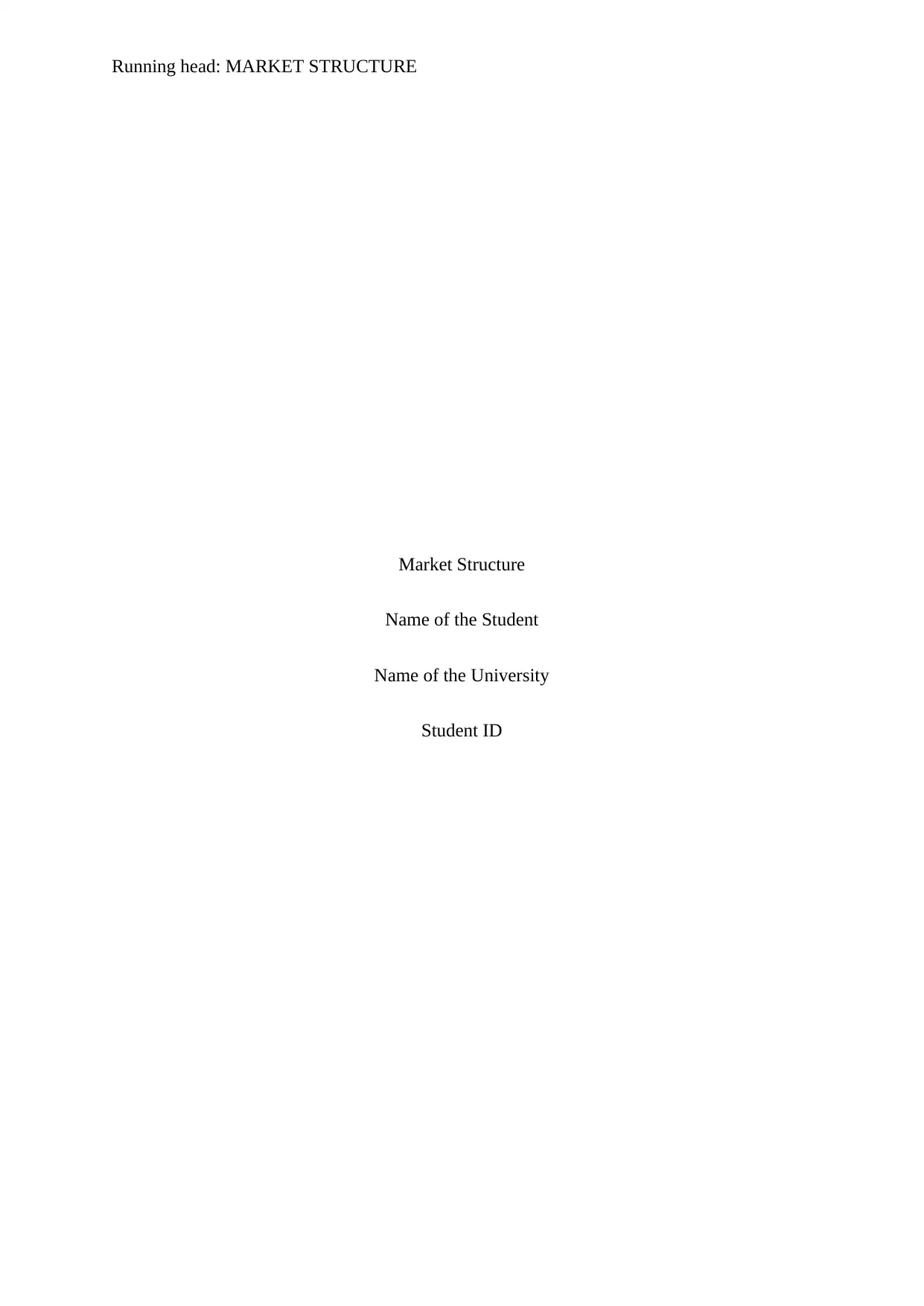
Running head: MARKET STRUCTURE
Market Structure
Name of the Student
Name of the University
Student ID
Market Structure
Name of the Student
Name of the University
Student ID
Paraphrase This Document
Need a fresh take? Get an instant paraphrase of this document with our AI Paraphraser

1MARKET STRUCTURE
Table of Contents
Answer 1....................................................................................................................................2
Answer 2....................................................................................................................................3
Answer 3....................................................................................................................................5
References..................................................................................................................................6
Table of Contents
Answer 1....................................................................................................................................2
Answer 2....................................................................................................................................3
Answer 3....................................................................................................................................5
References..................................................................................................................................6
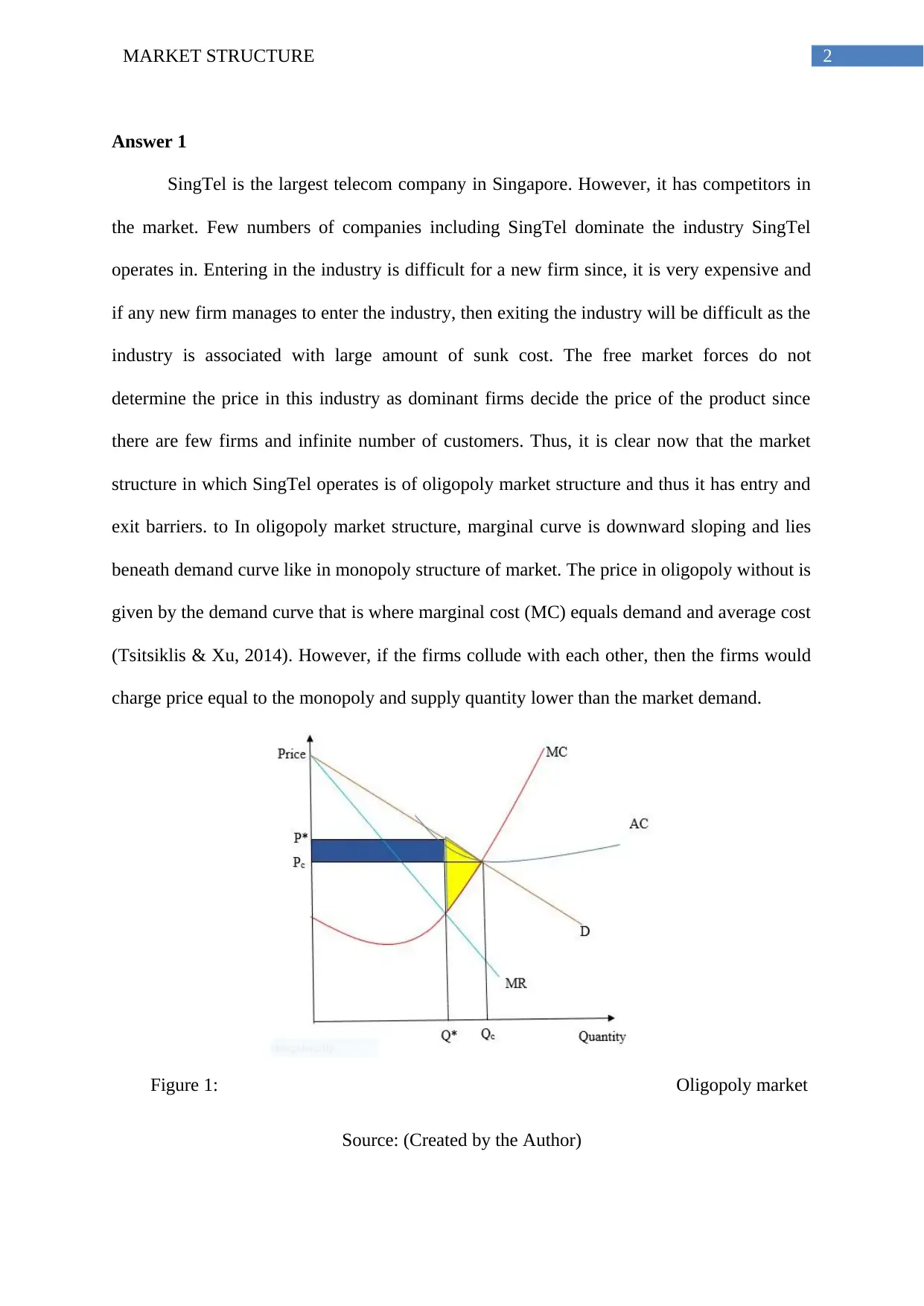
2MARKET STRUCTURE
Answer 1
SingTel is the largest telecom company in Singapore. However, it has competitors in
the market. Few numbers of companies including SingTel dominate the industry SingTel
operates in. Entering in the industry is difficult for a new firm since, it is very expensive and
if any new firm manages to enter the industry, then exiting the industry will be difficult as the
industry is associated with large amount of sunk cost. The free market forces do not
determine the price in this industry as dominant firms decide the price of the product since
there are few firms and infinite number of customers. Thus, it is clear now that the market
structure in which SingTel operates is of oligopoly market structure and thus it has entry and
exit barriers. to In oligopoly market structure, marginal curve is downward sloping and lies
beneath demand curve like in monopoly structure of market. The price in oligopoly without is
given by the demand curve that is where marginal cost (MC) equals demand and average cost
(Tsitsiklis & Xu, 2014). However, if the firms collude with each other, then the firms would
charge price equal to the monopoly and supply quantity lower than the market demand.
Figure 1: Oligopoly market
Source: (Created by the Author)
Answer 1
SingTel is the largest telecom company in Singapore. However, it has competitors in
the market. Few numbers of companies including SingTel dominate the industry SingTel
operates in. Entering in the industry is difficult for a new firm since, it is very expensive and
if any new firm manages to enter the industry, then exiting the industry will be difficult as the
industry is associated with large amount of sunk cost. The free market forces do not
determine the price in this industry as dominant firms decide the price of the product since
there are few firms and infinite number of customers. Thus, it is clear now that the market
structure in which SingTel operates is of oligopoly market structure and thus it has entry and
exit barriers. to In oligopoly market structure, marginal curve is downward sloping and lies
beneath demand curve like in monopoly structure of market. The price in oligopoly without is
given by the demand curve that is where marginal cost (MC) equals demand and average cost
(Tsitsiklis & Xu, 2014). However, if the firms collude with each other, then the firms would
charge price equal to the monopoly and supply quantity lower than the market demand.
Figure 1: Oligopoly market
Source: (Created by the Author)
⊘ This is a preview!⊘
Do you want full access?
Subscribe today to unlock all pages.

Trusted by 1+ million students worldwide
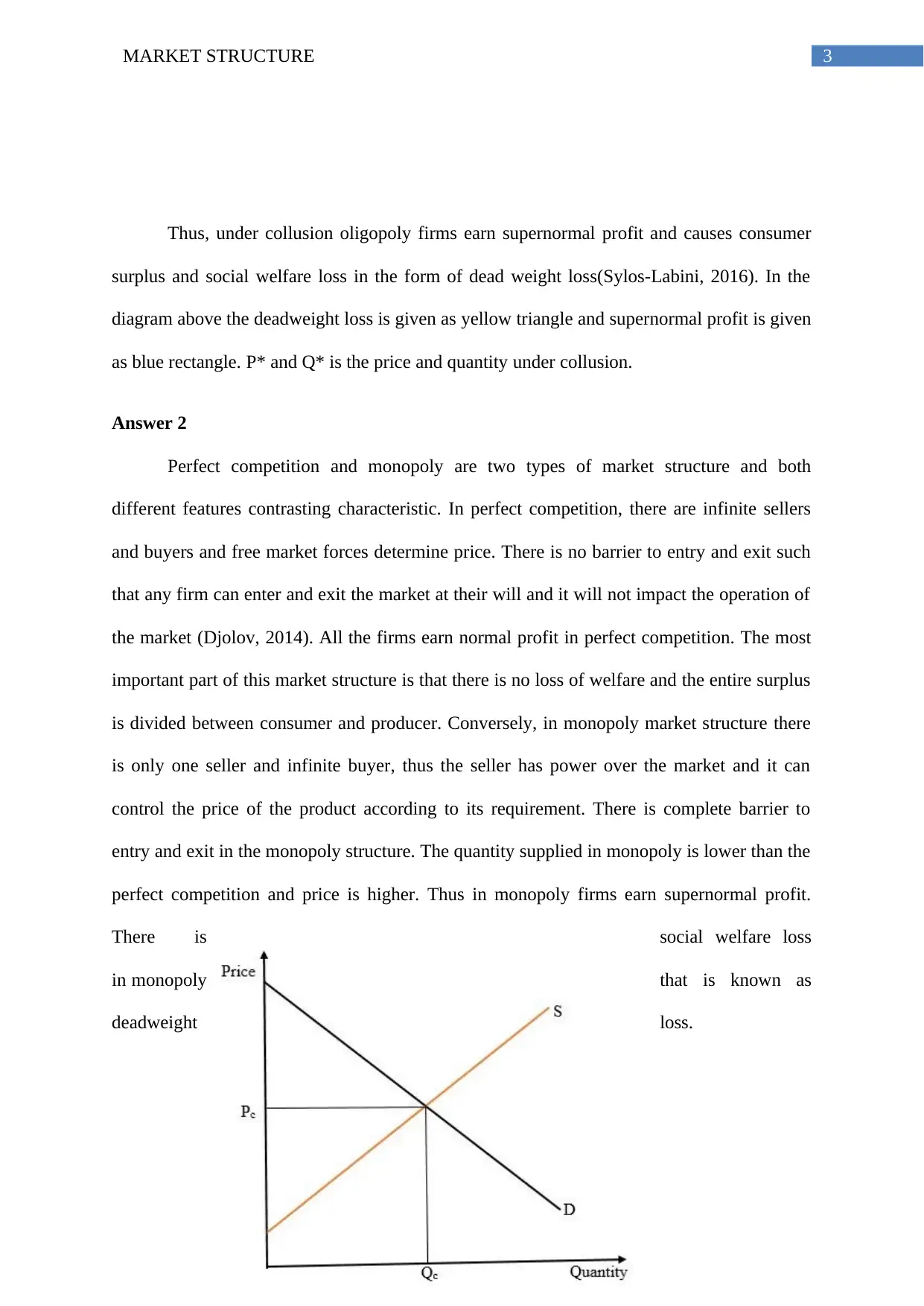
3MARKET STRUCTURE
Thus, under collusion oligopoly firms earn supernormal profit and causes consumer
surplus and social welfare loss in the form of dead weight loss(Sylos-Labini, 2016). In the
diagram above the deadweight loss is given as yellow triangle and supernormal profit is given
as blue rectangle. P* and Q* is the price and quantity under collusion.
Answer 2
Perfect competition and monopoly are two types of market structure and both
different features contrasting characteristic. In perfect competition, there are infinite sellers
and buyers and free market forces determine price. There is no barrier to entry and exit such
that any firm can enter and exit the market at their will and it will not impact the operation of
the market (Djolov, 2014). All the firms earn normal profit in perfect competition. The most
important part of this market structure is that there is no loss of welfare and the entire surplus
is divided between consumer and producer. Conversely, in monopoly market structure there
is only one seller and infinite buyer, thus the seller has power over the market and it can
control the price of the product according to its requirement. There is complete barrier to
entry and exit in the monopoly structure. The quantity supplied in monopoly is lower than the
perfect competition and price is higher. Thus in monopoly firms earn supernormal profit.
There is social welfare loss
in monopoly that is known as
deadweight loss.
Thus, under collusion oligopoly firms earn supernormal profit and causes consumer
surplus and social welfare loss in the form of dead weight loss(Sylos-Labini, 2016). In the
diagram above the deadweight loss is given as yellow triangle and supernormal profit is given
as blue rectangle. P* and Q* is the price and quantity under collusion.
Answer 2
Perfect competition and monopoly are two types of market structure and both
different features contrasting characteristic. In perfect competition, there are infinite sellers
and buyers and free market forces determine price. There is no barrier to entry and exit such
that any firm can enter and exit the market at their will and it will not impact the operation of
the market (Djolov, 2014). All the firms earn normal profit in perfect competition. The most
important part of this market structure is that there is no loss of welfare and the entire surplus
is divided between consumer and producer. Conversely, in monopoly market structure there
is only one seller and infinite buyer, thus the seller has power over the market and it can
control the price of the product according to its requirement. There is complete barrier to
entry and exit in the monopoly structure. The quantity supplied in monopoly is lower than the
perfect competition and price is higher. Thus in monopoly firms earn supernormal profit.
There is social welfare loss
in monopoly that is known as
deadweight loss.
Paraphrase This Document
Need a fresh take? Get an instant paraphrase of this document with our AI Paraphraser
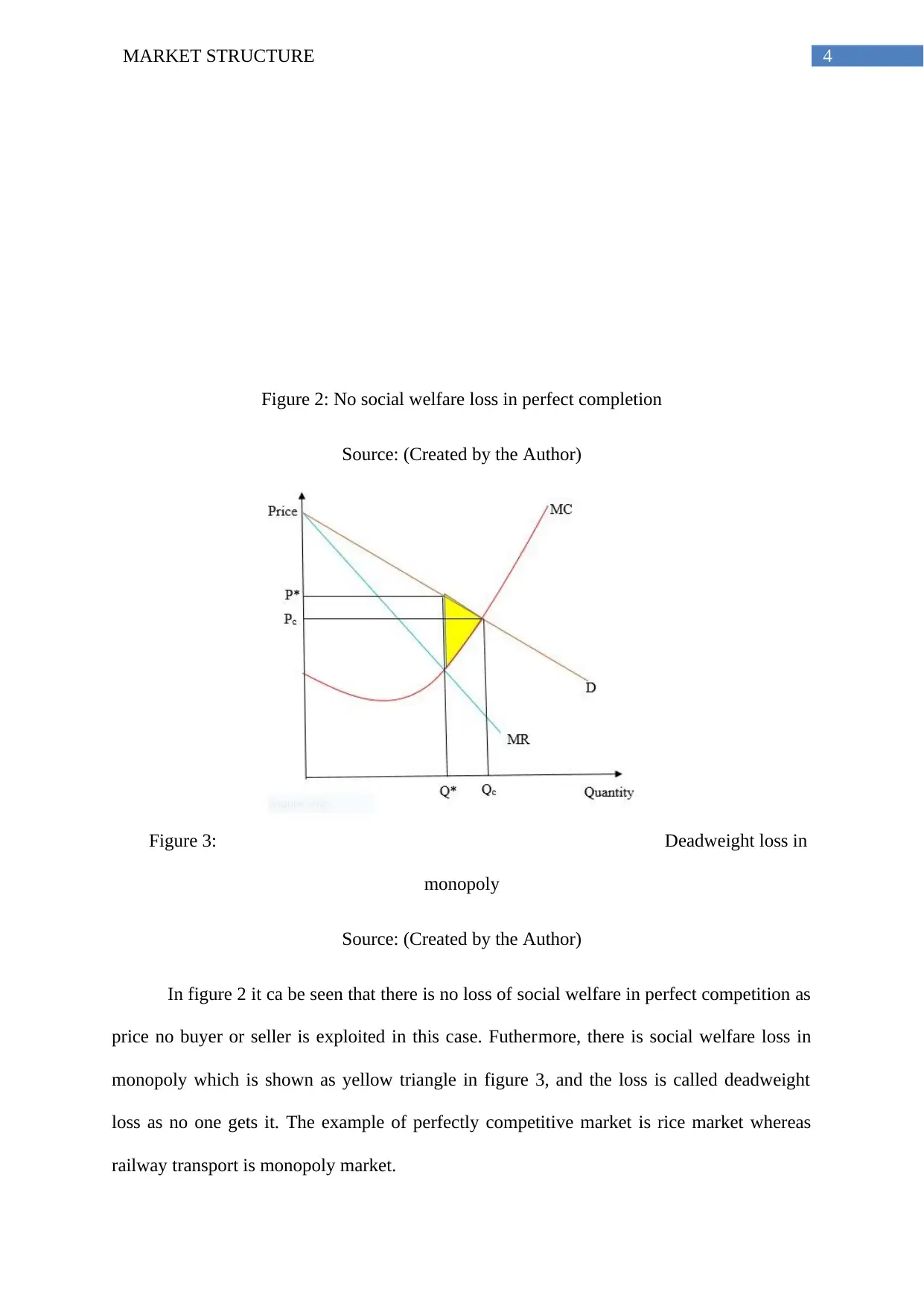
4MARKET STRUCTURE
Figure 2: No social welfare loss in perfect completion
Source: (Created by the Author)
Figure 3: Deadweight loss in
monopoly
Source: (Created by the Author)
In figure 2 it ca be seen that there is no loss of social welfare in perfect competition as
price no buyer or seller is exploited in this case. Futhermore, there is social welfare loss in
monopoly which is shown as yellow triangle in figure 3, and the loss is called deadweight
loss as no one gets it. The example of perfectly competitive market is rice market whereas
railway transport is monopoly market.
Figure 2: No social welfare loss in perfect completion
Source: (Created by the Author)
Figure 3: Deadweight loss in
monopoly
Source: (Created by the Author)
In figure 2 it ca be seen that there is no loss of social welfare in perfect competition as
price no buyer or seller is exploited in this case. Futhermore, there is social welfare loss in
monopoly which is shown as yellow triangle in figure 3, and the loss is called deadweight
loss as no one gets it. The example of perfectly competitive market is rice market whereas
railway transport is monopoly market.
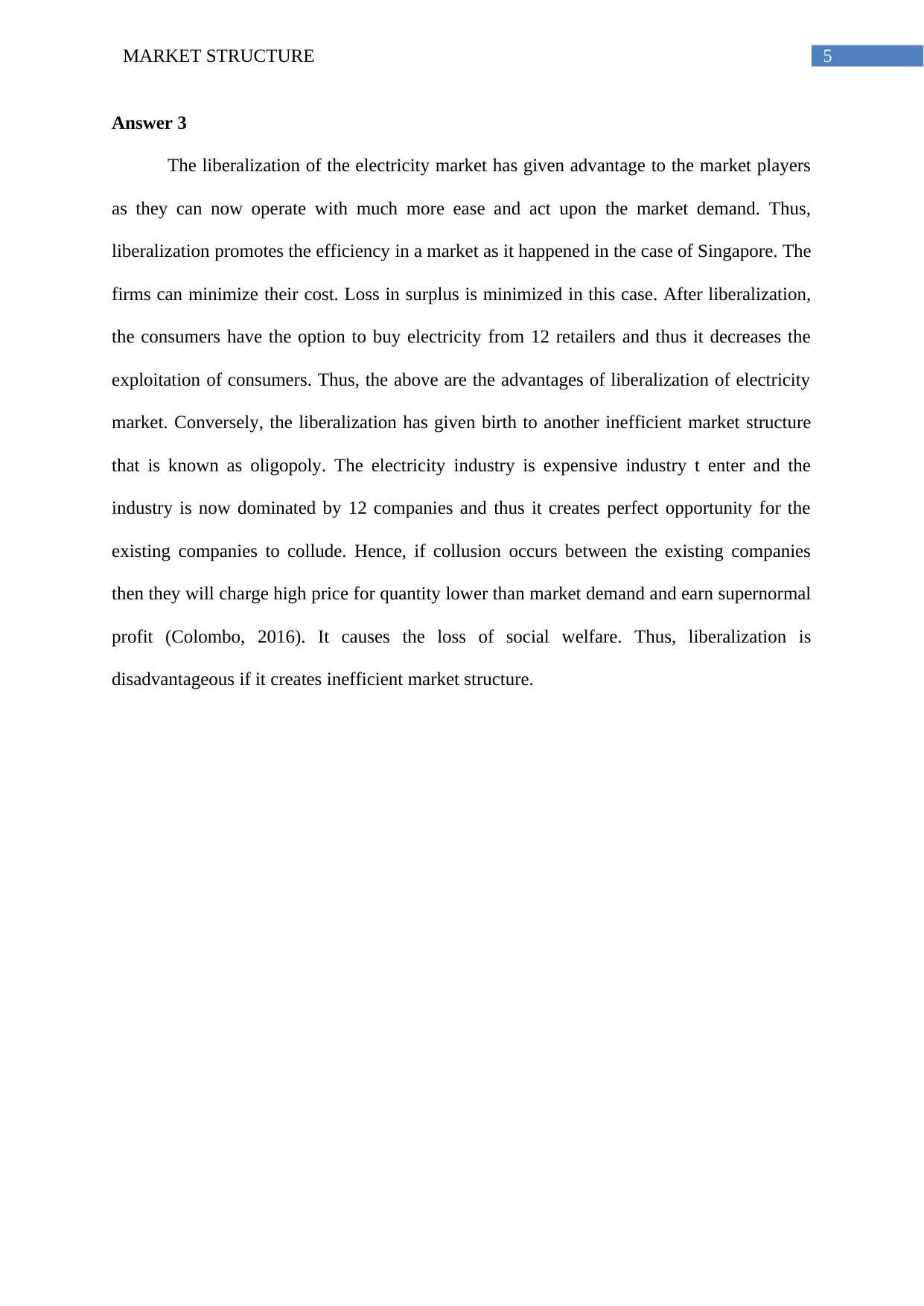
5MARKET STRUCTURE
Answer 3
The liberalization of the electricity market has given advantage to the market players
as they can now operate with much more ease and act upon the market demand. Thus,
liberalization promotes the efficiency in a market as it happened in the case of Singapore. The
firms can minimize their cost. Loss in surplus is minimized in this case. After liberalization,
the consumers have the option to buy electricity from 12 retailers and thus it decreases the
exploitation of consumers. Thus, the above are the advantages of liberalization of electricity
market. Conversely, the liberalization has given birth to another inefficient market structure
that is known as oligopoly. The electricity industry is expensive industry t enter and the
industry is now dominated by 12 companies and thus it creates perfect opportunity for the
existing companies to collude. Hence, if collusion occurs between the existing companies
then they will charge high price for quantity lower than market demand and earn supernormal
profit (Colombo, 2016). It causes the loss of social welfare. Thus, liberalization is
disadvantageous if it creates inefficient market structure.
Answer 3
The liberalization of the electricity market has given advantage to the market players
as they can now operate with much more ease and act upon the market demand. Thus,
liberalization promotes the efficiency in a market as it happened in the case of Singapore. The
firms can minimize their cost. Loss in surplus is minimized in this case. After liberalization,
the consumers have the option to buy electricity from 12 retailers and thus it decreases the
exploitation of consumers. Thus, the above are the advantages of liberalization of electricity
market. Conversely, the liberalization has given birth to another inefficient market structure
that is known as oligopoly. The electricity industry is expensive industry t enter and the
industry is now dominated by 12 companies and thus it creates perfect opportunity for the
existing companies to collude. Hence, if collusion occurs between the existing companies
then they will charge high price for quantity lower than market demand and earn supernormal
profit (Colombo, 2016). It causes the loss of social welfare. Thus, liberalization is
disadvantageous if it creates inefficient market structure.
⊘ This is a preview!⊘
Do you want full access?
Subscribe today to unlock all pages.

Trusted by 1+ million students worldwide
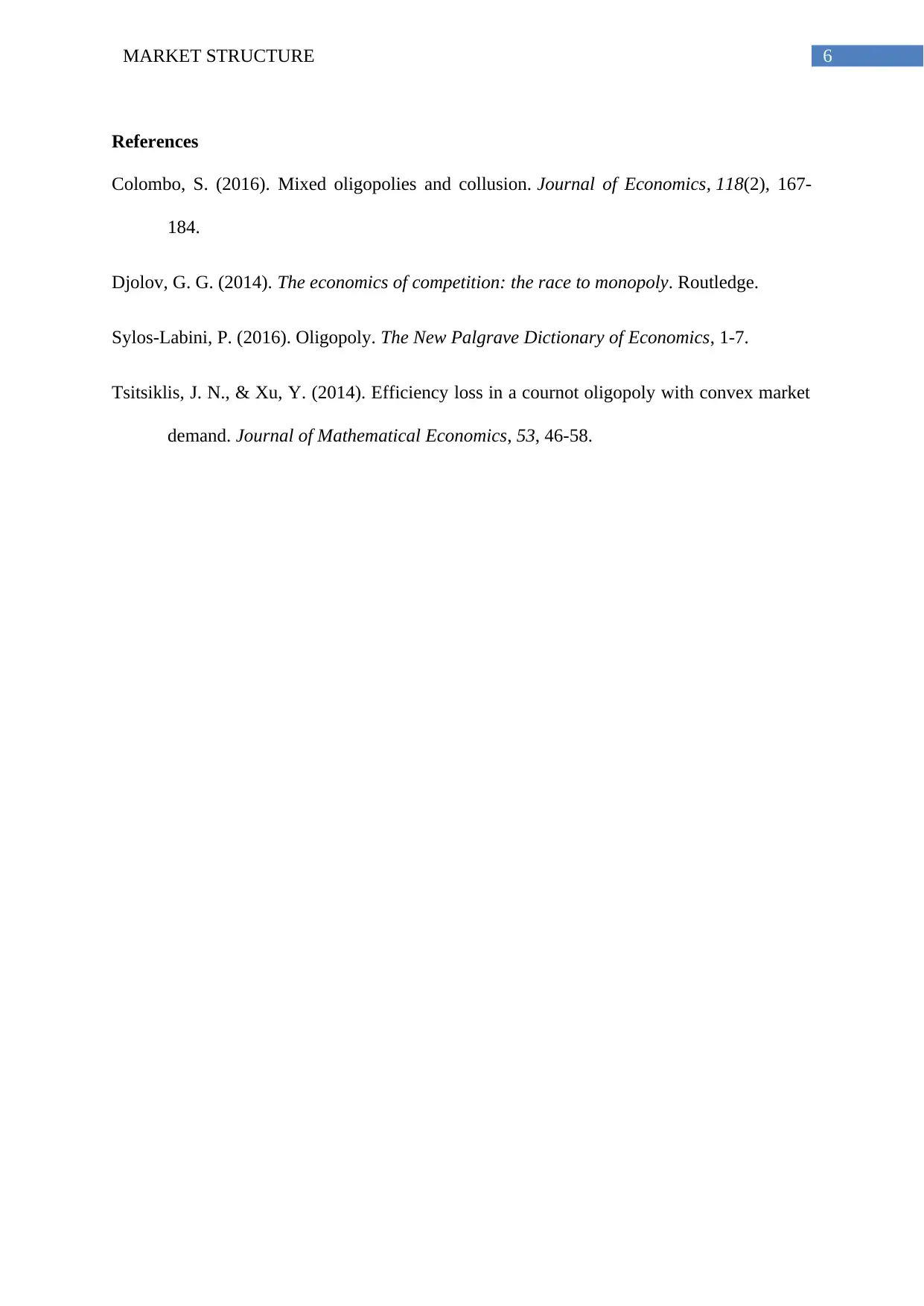
6MARKET STRUCTURE
References
Colombo, S. (2016). Mixed oligopolies and collusion. Journal of Economics, 118(2), 167-
184.
Djolov, G. G. (2014). The economics of competition: the race to monopoly. Routledge.
Sylos-Labini, P. (2016). Oligopoly. The New Palgrave Dictionary of Economics, 1-7.
Tsitsiklis, J. N., & Xu, Y. (2014). Efficiency loss in a cournot oligopoly with convex market
demand. Journal of Mathematical Economics, 53, 46-58.
References
Colombo, S. (2016). Mixed oligopolies and collusion. Journal of Economics, 118(2), 167-
184.
Djolov, G. G. (2014). The economics of competition: the race to monopoly. Routledge.
Sylos-Labini, P. (2016). Oligopoly. The New Palgrave Dictionary of Economics, 1-7.
Tsitsiklis, J. N., & Xu, Y. (2014). Efficiency loss in a cournot oligopoly with convex market
demand. Journal of Mathematical Economics, 53, 46-58.
1 out of 7
Related Documents
Your All-in-One AI-Powered Toolkit for Academic Success.
+13062052269
info@desklib.com
Available 24*7 on WhatsApp / Email
![[object Object]](/_next/static/media/star-bottom.7253800d.svg)
Unlock your academic potential
Copyright © 2020–2025 A2Z Services. All Rights Reserved. Developed and managed by ZUCOL.





